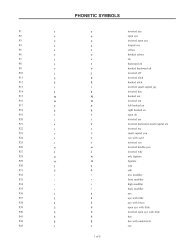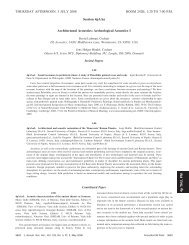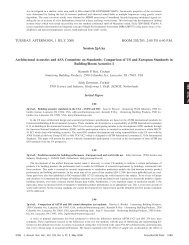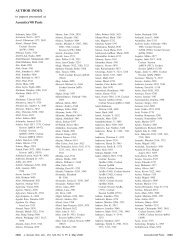Tuesday afternoon, 11 November - The Acoustical Society of America
Tuesday afternoon, 11 November - The Acoustical Society of America
Tuesday afternoon, 11 November - The Acoustical Society of America
You also want an ePaper? Increase the reach of your titles
YUMPU automatically turns print PDFs into web optimized ePapers that Google loves.
e.g., temperature that is then digitized. <strong>The</strong> digitized bits are used to vary<br />
the electrical load applied to the electrical terminals <strong>of</strong> the inside transducer<br />
by changing its acoustic impedance in accordance with the data bits. <strong>The</strong><br />
impedance changes, in turn, modulate the amplitude <strong>of</strong> the reflected ultrasonic<br />
signal. This modulated signal is detected at the outside receiving as<br />
well as transmitting transducer, where it is then demodulated to recover the<br />
data. Additionally, some <strong>of</strong> the acoustic power received at the inside transducer<br />
is harvested to produce the electrical power needed to operate the<br />
communication and sensor system on the inside. Digital data communication<br />
rates exceeding 50 000 bits/s are achieved.<br />
2:45<br />
2pEA6. Measurement uncertainties caused by tapping machines in floor<br />
sound insulation tests. Valentin Buzduga Scantek Inc., 7060 Oakland<br />
Mills Rd., Ste. L, Columbia, MD 21045, buzdugav@scantekinc.com<br />
This paper illustrates how the parameters <strong>of</strong> the tapping machine may<br />
influence the measurement accuracy when testing the impact sound insulation<br />
<strong>of</strong> floors. <strong>The</strong> analysis connects the specifications for tapping machines<br />
given in ISO 140-6 and ASTM E 492-4 standards with the requirements for<br />
repeatability and reproducibility <strong>of</strong> the sound insulation measurements given<br />
in ISO 140-2. <strong>The</strong> paper also discusses calibration and testability aspects for<br />
tapping machines and presents the method developed at Scantek for measuring<br />
the impact velocity <strong>of</strong> the hammers. <strong>The</strong> paper gives modeling equations,<br />
preliminary calculations for measurement uncertainties, and experimental<br />
results obtained at Scantek on calibrating the Norsonic tapping<br />
machine N-2<strong>11</strong>.<br />
3:00<br />
2pEA7. Ultra-wide-band filter for noise control. Manvir Kushwaha Inst.<br />
<strong>of</strong> Phys., Univ. <strong>of</strong> Puebla, P.O. Box J-45, 72570 Puebla, Mexico<br />
Extensive band structures are performed for two-dimensional periodic<br />
arrays <strong>of</strong> rigid stainless steel cylinders in air, with Bloch vector being perpendicular<br />
to the cylinders. We embark on the opening up <strong>of</strong> a complete<br />
acoustic band gap—independent <strong>of</strong> the polarization <strong>of</strong> the wave and <strong>of</strong> the<br />
direction <strong>of</strong> propagation. In addition, we propose the fabrication <strong>of</strong> a multiperiodic<br />
system in tandem that could create a huge hole in sound within the<br />
human audible range <strong>of</strong> frequencies.<br />
3:15<br />
2pEA8. Effect <strong>of</strong> sound amplitude on the acoustic attenuation<br />
characteristics <strong>of</strong> Helmholtz resonators. Asim Iqbal Dept. <strong>of</strong> Mech. Eng.<br />
and <strong>The</strong> Ctr. for Automotive Res., <strong>The</strong> Ohio State Univ., 201 W. 19th Ave.,<br />
Columbus, OH 43210, iqbal.27@osu.edu and Ahmet Selamet <strong>The</strong> Ohio<br />
State Univ., Columbus, OH 43210<br />
Influence <strong>of</strong> sound amplitude on the acoustic attenuation performance <strong>of</strong><br />
a Helmholtz resonator is investigated computationally. Time-dependent and<br />
compressible flow field is determined by solving two-dimensional unsteady,<br />
turbulent, and compressible Navier–Stokes equations through an implicit<br />
and noniterative pressure-implicit-splitting-<strong>of</strong>-operators algorithm. <strong>The</strong> solution<br />
<strong>of</strong> full Navier–Stokes equations remedies the constraints in small-<br />
amplitude-wave treatments, thereby allowing a proper modeling <strong>of</strong> nonlinearities<br />
due to large amplitudes. Transmission loss <strong>of</strong> the Helmholtz<br />
resonator is then calculated for discrete inlet amplitudes using the pressure<br />
obtained from the flow field. Higher amplitudes are shown in this study to<br />
reduce the peak transmission loss significantly.<br />
3:30<br />
2pEA9. Experimental characterization <strong>of</strong> a biomimetic differential<br />
microphone diaphragm. Ronald Miles, Weili Cui Dept. <strong>of</strong> Mech. Eng.,<br />
SUNY at Binghamton, Binghamton, NY 13902-6000,<br />
miles@binghamton.edu, and Mihir Shetye Solteras, City <strong>of</strong> Industry, CA<br />
91748<br />
<strong>The</strong> identification <strong>of</strong> mechanical properties for a microphone diaphragm<br />
based on the coupled ears <strong>of</strong> the fly Ormia ochracea and fabricated out <strong>of</strong><br />
polycrystalline silicon is described. An acoustic test setup using a laser vibrometer<br />
has been developed that facilitates the characterization <strong>of</strong> the diaphragm<br />
on a bare die level. A major problem with using a laser vibrometer<br />
for acoustic measurement <strong>of</strong> microstructures is the close working distance<br />
between the sensor head and test device, resulting in measurements corrupted<br />
by reflections. Time select windowing procedures are <strong>of</strong>ten used to<br />
obtain anechoic response estimates from measurements taken in reverberant<br />
environments, but are not effective for characterization at lower frequencies<br />
or testing <strong>of</strong> lightly damped structures where the time window length needs<br />
to be more than the reverberation time. It is shown that the reflections from<br />
the measured response <strong>of</strong> the biologically inspired diaphragm can be reduced<br />
through comparison methods for the calibration <strong>of</strong> the sound field using<br />
a closely placed probe microphone and a commercially available pressure<br />
differential microphone. Equivalent mechanical parameters for the<br />
diaphragm are estimated with a least squares identification procedure. Characterization<br />
results for a diaphragm with two different back volume configurations<br />
are compared. Work supported by NIH.<br />
3:45<br />
2pEA10. Testing microphones in small acoustical enclosures. Mariana<br />
Buzduga and Valentin Buzduga Scantek, Inc., 7060 Oakland Mills Rd., Ste.<br />
L, Columbia, MD 21046, buzdugam@scantekinc.com<br />
For both instrument calibration and testing, there is a need for faster and<br />
more economical test methods, while keeping the test accuracy within acceptable<br />
limits. We analyze the use <strong>of</strong> a small acoustical enclosure that is not<br />
strictly “anechoic” but provides a test environment that can be used to make<br />
measurements with a predictably high degree <strong>of</strong> repeatability for testing the<br />
frequency characteristics <strong>of</strong> the microphones or the influence <strong>of</strong> their accessories<br />
windscreen and grids. First, the characteristics <strong>of</strong> the acoustical field<br />
in the enclosure are discussed. <strong>The</strong>n the sensitivity <strong>of</strong> two test methods to<br />
specific influencing parameters is analyzed. <strong>The</strong> first method is the successive<br />
comparison using a reference microphone. <strong>The</strong> second method is a simultaneous<br />
comparison based on the constant divergence <strong>of</strong> the sound pressure<br />
in the field V. Buzduga and M. Buzduga, “<strong>Acoustical</strong> test methods<br />
based on the constant divergence <strong>of</strong> the sound pressure level,” Noise Control<br />
Eng. J., 516, 343–347 2003. <strong>The</strong> accuracy <strong>of</strong> the tests and the frequency<br />
domain <strong>of</strong> possible use for each method are discussed.<br />
2488 J. Acoust. Soc. Am., Vol. 124, No. 4, Pt. 2, October 2008 156th Meeting: <strong>Acoustical</strong> <strong>Society</strong> <strong>of</strong> <strong>America</strong><br />
2488







